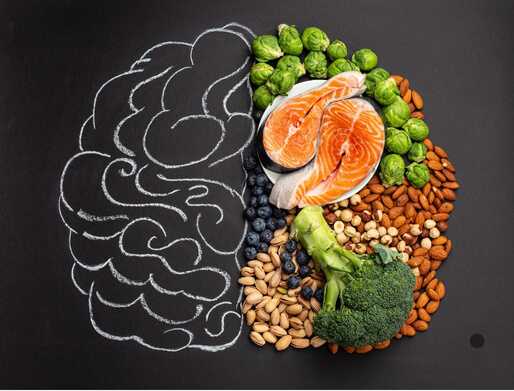
As a physiotherapist focussing on the treatment of headaches and migraines, I’ve seen how gut health can significantly impact migraine management.
Recent research highlights the gut-brain axis’s role in migraines, offering new holistic treatment avenues.
Let’s explore this connection and discuss five strategies to manage migraines through gut health, and how physiotherapy, specifically the Watson Headache® Approach, can help.
The Gut-Brain Axis: What’s Going On?
The gut-brain axis is a communication network linking your gut and central nervous system (CNS), involving interactions between gut microbiota, the immune system, and the CNS. Disruptions in gut microbiota can influence inflammatory responses, potentially triggering migraines (Arzani et al., 2020).
Gut Health and Migraines: The Connection

Migraines often come with gut issues like nausea. Your gut and brain communicate via neural, hormonal, and immune pathways. Neurotransmitters like serotonin and glutamate, crucial in migraines, are also found in the gut (Llamas & Baity, 2024). An imbalanced gut microbiome can lead to “leaky gut,” allowing pro-inflammatory substances into the bloodstream and brain, triggering migraines (Su et al., 2021).
Five Ways to Manage Migraines Through Gut Health
- Optimise Your Diet: Incorporate fibre-rich foods like fruits, vegetables, and whole grains to nourish beneficial gut bacteria. Prebiotics and probiotics are beneficial (Nagy-Grócz, 2023).
- Identify and Avoid Triggers: Keep a food diary to identify and avoid triggers like caffeine, alcohol, and processed meats (Llamas & Baity, 2024).
- Manage Stress: Techniques like mindfulness, meditation, and regular physical activity can maintain gut health and reduce migraines (Arzani et al., 2020).
- Stay Hydrated: Drink at least eight glasses of water a day to avoid dehydration, a common migraine trigger (Su et al., 2021).
- Consider Supplements: Supplements like probiotics, magnesium, riboflavin (B2), and coenzyme Q10 can support gut health and reduce migraines (Nagy-Grócz, 2023).
The Watson Headache® Approach
Now, let’s talk about how physiotherapy, specifically the Watson Headache® Approach, can help manage migraines by addressing the interconnected systems of the gut and the CNS.
- Cervical Spine Assessment and Treatment
The Watson Headache® Approach focuses on identifying and treating dysfunctions in the upper cervical spine that may contribute to migraines. By applying gentle, sustained pressure to specific cervical segments, physiotherapists can alleviate referred pain and reduce the frequency and intensity of migraines (Watson & Drummond, 2012).
- Posture and Musculoskeletal Health
Poor posture and musculoskeletal imbalances can exacerbate both gut and CNS issues, contributing to migraines. The Watson Headache® Approach includes posture correction and ergonomic advice to address these underlying factors, improving overall health and reducing migraine triggers (Watson & Drummond, 2012).
- Holistic Management Strategies
Integrating the Watson Headache® Approach with strategies that promote gut health can offer a holistic solution for migraine sufferers. This includes dietary modifications, hydration, stress management, and targeted exercises to support both gut and cervical spine health (Nagy-Grócz, 2023).
Is It Time To Follow Your Gut?
The link between the gut, central nervous system, and migraines is complex and multifaceted. Understanding this connection can lead to more effective, holistic treatment strategies.
The Watson Headache® Approach, with its focus on the cervical spine and its impact on the trigeminal nerve, offers a valuable tool for physiotherapists in managing migraines. By incorporating gut health strategies and addressing musculoskeletal factors, we can provide comprehensive care that targets the root causes of migraines.
If you’re struggling with migraines, consider booking an assessment with our team. We’re here to help you understand your condition and provide tailored treatment plans.
Written by:
References
Arzani, M., Jahromi, S. R., Ghorbani, Z., & Martelletti, P. (2020). Gut-brain axis and migraine headache: A comprehensive review. *The Journal of Headache and Pain*, 21(1), 1-15. https://doi.org/10.1186/s10194-020-01135-8
Llamas, C., & Baity, J. (2024). What the Amazing Gut-Brain Connection Means for Your Migraine. Migraine Again. Retrieved from https://www.migraineagain.com/gut-brain-connection-migraine/
Nagy-Grócz, G. (2023). All roads lead to the gut: The importance of the microbiota and diet in migraine. *Neurology International*, 15(3), 1174-1190. https://doi.org/10.3390/neurolint15030073
Su, Q., Zhang, H., Zhang, Y., Zhang, Z., & Li, S. (2021). A causal effects of gut microbiota in the development of migraine. *The Journal of Headache and Pain*, 22(1), 1-9. https://doi.org/10.1186/s10194-021-01253-4
Watson, D. H., & Drummond, P. D. (2012). Headache and the cervical spine: The role of mobilization therapy. In *Manual Therapy for the Cranial Nerves* (pp. 209-223). Elsevier.









